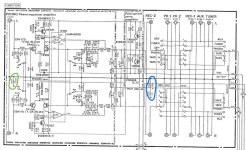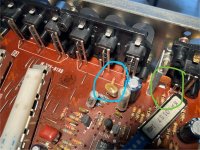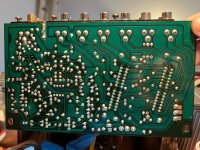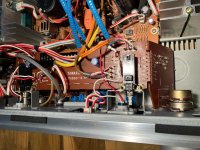Reversing the power plug for the amplifier causes no change to the hum when a source with a 3-prong plug is connected.
Exactly!
... but I assume it would not be advisable to use the setup, longterm, that way?
I would say no - it's not advisable ... but then, I'm from Oz (not the USofA, like wparks).
In Oz, we have 3-pin plugs as standard - ie. earth is always provided, at every power point. Hence, I ground the chassis to the earth pin on the IEC socket, as a matter of course.
But I also always ensure RCA sockets are isolated from the chassis ... so that there is no direct connection between signal ground and mains earth.
WParks, if you're still paying attention to this thread, I've loosened up the function board you mentioned, and I spent a few days attempting to understand it against the schematics in the service manual to identify which two 0.033uF caps you're referring to. (Anything circuit board related is all brand new to me, but slowly getting a handle on it). Here are a couple of pics, and a couple of questions.In the "function" board where all of the RCA inputs are received, the ground sleeve of each of the inputs are brought to a common ground on the function board, but this ground is not meant to be tied to the chassis here- the schematic shows this board ground connected to the chassis only through two 0.033uF caps, which would be to shunt RF frequencies to chassis ground, but are an "open" for DC or audible frequencies. The only place this function board ground is shown connecting anywhere is through the shield wrapped around the selected "input" signal that leaves the function board going to the "tone control 2" and "tone control 3" boards where the volume control and main direct switch is.
Circled in green - I think we've got the phono input shield connecting to ceramic disc capacitor C123, stamped with 333Z, and that's in turn connected to a metal 'wall' on the circuit board that's screwed to the chassis.
Circled in blue - I think all line I/O shields are connected to R143 (the 2.2Ω resistor) and then to the C124 capacitor, which then also connects to that grounding point on the chassis. The odd thing is on the circuit schematic it seems to show the capacitor and resistor in the opposite order, and that capacitor looks completely different—it's not a ceramic disc, it's a yellowish film capacitor, maybe. And I see no markings on it, but the very top has a brownish tint to it.
Have I got the right capacitors? Despite looking different, could they both be 0.033uF caps attaching RCAs to the chassis ground? Since my ground buzz is happening with the line I/O (not phono input) I feel like the thicker, yellowish film capacitor is the one to test, and that slight brownish tinge may be a visual confirmation that it's gone bad. Unfortunately my multimeter is a cheap one that doesn't test for capacitance (and certainly not an ESR meter that could test it in-circuit). Could a resistance test in-circuit tell me what I need to know? (And these caps are all such low voltage that I could discharge them in-circuit using a discharge tool with a resistor in it, yes?)
Thanks again!
Attachments
-
 A760 Function Board BLUE CIRCLE Line Input Shield Thru C124 0.33uf Cap + R143 2.2Ω Resistor To...jpg142.7 KB · Views: 25
A760 Function Board BLUE CIRCLE Line Input Shield Thru C124 0.33uf Cap + R143 2.2Ω Resistor To...jpg142.7 KB · Views: 25 -
 Function C Board - BLUE CIRCLE Line Input Shield Thru R143 2.2Ω Resistor To C124 Film Capacito...jpg547 KB · Views: 20
Function C Board - BLUE CIRCLE Line Input Shield Thru R143 2.2Ω Resistor To C124 Film Capacito...jpg547 KB · Views: 20 -
 A760 Function (IO) Circuit Board Component Side.jpg701.2 KB · Views: 25
A760 Function (IO) Circuit Board Component Side.jpg701.2 KB · Views: 25 -
 A760 Function (IO) Circuit Board Trace Side.jpg543.3 KB · Views: 22
A760 Function (IO) Circuit Board Trace Side.jpg543.3 KB · Views: 22
Your analysis of the connectivity of the function board is correct. The chassis ground is connected to chassis at only the sheet metal tab and screw next to the phono connector. The actual signal ground (from ALL the input RCA sleeves) all ties together and exits the function board on the E pins of S1 and S2 which is the shield wire of the brown and orange? wires at the bottom left of the picture. The two capacitors are identified correctly. (Don't sweat the resistor capacitor order, it is arbitrary.) These capacitors don't go bad, really. The yellow capacitor is a poly/film cap and they tend to yellow, and the other is ceramic and they are both fine, I would not replace them. The only capacitors you might think about discharging are the big electrolytic storage caps. You can measure the voltage from + to - legs on these are see if a voltage is hanging around or not. Some will stay charged for hours, others will discharge quickly- depends upon design.
I don't think the problem is on the function board, and I indicated that. This hum could be a disconnect or bad/flaky connection in the signal ground, but it would be between the function board and probably the tone control 1 board, likely in/around the tone 3 board where the main direct switch is. The signal shields enter the tone3 board at the S1E/S2E pins and pass through the main direct switch, becomes the ground of the volume control (jumping through connectors from board to board, or are direct wired?) then to tone control 1, then on to the amplifier. The schematic is pretty difficult to follow, especially chopped up, so I sort of lose track of ground at the tone control 1 and amplifier connections. I still think the main direct switch is a culprit, because it switches the signal ground as well as the signal. Funky design. Does this problem ever come and go with the activation/nudging/tapping on this switch? Did you clean it?
I don't think the problem is on the function board, and I indicated that. This hum could be a disconnect or bad/flaky connection in the signal ground, but it would be between the function board and probably the tone control 1 board, likely in/around the tone 3 board where the main direct switch is. The signal shields enter the tone3 board at the S1E/S2E pins and pass through the main direct switch, becomes the ground of the volume control (jumping through connectors from board to board, or are direct wired?) then to tone control 1, then on to the amplifier. The schematic is pretty difficult to follow, especially chopped up, so I sort of lose track of ground at the tone control 1 and amplifier connections. I still think the main direct switch is a culprit, because it switches the signal ground as well as the signal. Funky design. Does this problem ever come and go with the activation/nudging/tapping on this switch? Did you clean it?
Ah, okay thank you. So I've put the Function board back in and I cleaned/worked the Main Direct and Disc switches plus the volume control for good measure. The reason I left that for last is this unit spent a year at a shop, and the final thing they did to it was a thorough check of the tone circuit. They did this to address the ground hum/RF noise I was describing, but they actually never heard the problem at their shop because they were using 2-prong and battery-powered audio sources and I discovered upon getting it back that it was actually only happening with my 3-prong sources. They said they replaced some components on one or more Tone Boards including capacitors and an integrated circuit (which I'm not seeing on the schematic so I wonder if I misunderstood). But I imagined they checked all the solder joints etc. on these boards in the process and cleaned the switches, and the hum/buzz existed both before and after they worked on it.
Also—see attached pic—the S1E/S2E pins go into Tone Board 2 close to the Disc switch, and if I'm reading the schematic right they pass through that switch first, then the Volume control (on Tone Board 3 which is attached at an angle by 7 direct-connected stitched wires) then finally to the Main Direct Switch before they're off to the amp?
After cleaning and working the switches, I powered up, plugged in a 3-pronged audio device and a pair of headphones and unfortunately the hum/buzz still persists. And there's no difference in the nature of the hum/buzz if the Main Direct or Disc switches are engaged/fiddled with or if the volume control is altered.
But I learned something else—and I can't be sure if this is new or just wasn't noticed before: when all audio sources are disconnected (i.e. nothing is plugged into the inputs) there's a duller hum on the right channel that becomes noticeable on headphones as the volume is turned up. IF the Main Direct switch is engaged, at about 75% a relay clicks in and cuts the amp out. If it's not engaged, the relay clicks in and cuts out the amp close to 100% volume. Could this be a clue?
I suppose it's possible this is a separate (and maybe even new) issue...like possibly one of the filter caps is now failing? But the hum strikes me as AC leakage, and may be a new symptom of the more pronounced hum/buzz that I confirmed to have a 60 Hz fundamental when a 3-prong device is brought in as an audio source.
Also—see attached pic—the S1E/S2E pins go into Tone Board 2 close to the Disc switch, and if I'm reading the schematic right they pass through that switch first, then the Volume control (on Tone Board 3 which is attached at an angle by 7 direct-connected stitched wires) then finally to the Main Direct Switch before they're off to the amp?
After cleaning and working the switches, I powered up, plugged in a 3-pronged audio device and a pair of headphones and unfortunately the hum/buzz still persists. And there's no difference in the nature of the hum/buzz if the Main Direct or Disc switches are engaged/fiddled with or if the volume control is altered.
But I learned something else—and I can't be sure if this is new or just wasn't noticed before: when all audio sources are disconnected (i.e. nothing is plugged into the inputs) there's a duller hum on the right channel that becomes noticeable on headphones as the volume is turned up. IF the Main Direct switch is engaged, at about 75% a relay clicks in and cuts the amp out. If it's not engaged, the relay clicks in and cuts out the amp close to 100% volume. Could this be a clue?
I suppose it's possible this is a separate (and maybe even new) issue...like possibly one of the filter caps is now failing? But the hum strikes me as AC leakage, and may be a new symptom of the more pronounced hum/buzz that I confirmed to have a 60 Hz fundamental when a 3-prong device is brought in as an audio source.
